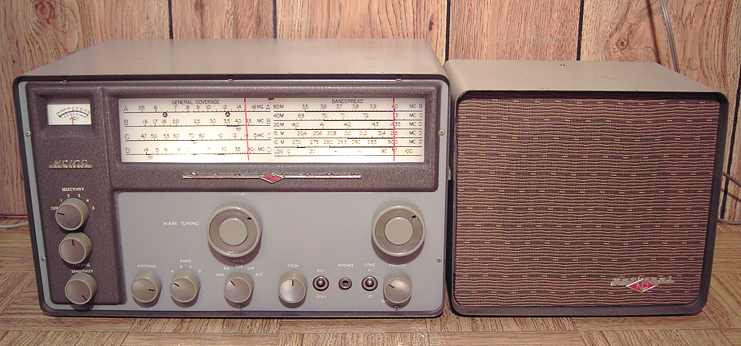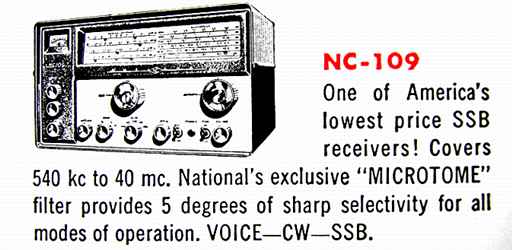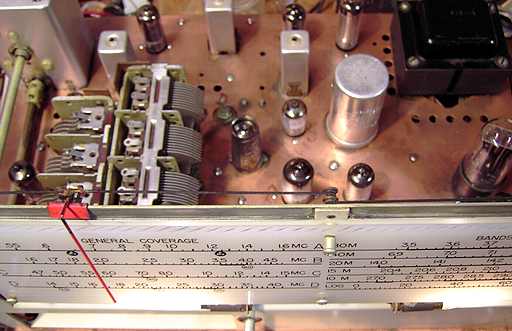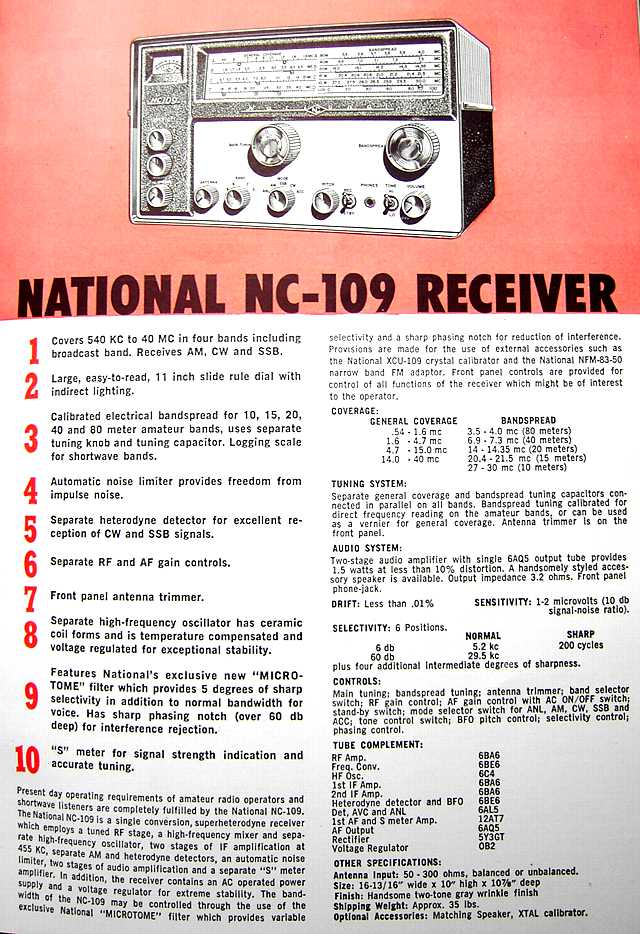
The National NC-109 is an 11 tube general coverage single conversion receiver covering 550 KHz to 40 MHz in 4 bands. Has BFO, electrical bandspread marked for the Ham bands, crystal filter, product detector, and separate RF gain and volume controls. The tubes in this set are 6C4 oscillator, 6AL5 as detector, AVC and noise limiter, two 6BA6 as IF amps and a third as RF amp, one 6BE6 as converter and a second as heterodyne detector and BFO, 12AV7 as first AF amp and S meter amp, 6AQ5 audio output, 0B2 voltage regulator, and 5Y3 rectifier. It was introduced in 1957 at a price of $199.95. A review can be found in the January 1958 issue of QST magazine. The NTS-1 matching speaker was an optional accessory.
The NC-188 is a reduced-cost same-size twin without the crystal filter, product detector, or voltage regulator. It was priced at $159.95.

Ads for the NC-109 receiver can be found in the ARRL Handbooks. This ad is from 1960.

Condition
The overall cosmetic condition of this set was very good as purchased and cleaned up easily. The light gray top areas for both the cabinet and speaker have some scuffs and will be painted at a later date.
A partial manual and schematic for the NC-109 can be found on BAMA although the quality leaves much to be desired. If you have a decent original manual, please provide BAMA with good quality scans or a PDF.
Repairs
The capacitors in this set are mostly ceramic or better quality tubulars. I replaced the power line filter cap as a matter of course but none of the others. After a slow power-up the set was working on the broadcast band. Sensitivity seemed to be lacking somewhat. Contact cleaner solved an intermittent volume control problem. Applying contact cleaner to the bandswitch solved much of the sensitivity problem, bringing a local station from an S-9 reading on the S-meter to the maximum reading of 40 dB over S-9. I also applied contact cleaner to the tube sockets and the other controls. The IFs were aligned on the crystal which was only about 440 Hertz below the 455 KHz design (about 454.56 KHz). The adjustments for the crystal filter were off the mark. Both the coil and the trimmer cap in the crystal filter housing (labeled as Z4) needed some adjustment. The trimmer cap was well off the mark and was the chief cause of the crystal filter switch position 1 and 2 showing greater receiver sensitivity than the "off" position. An alignment tweaking for the RF amp and oscillator for band "A" brought the broadcast band to excellent performance. I confidently expected the same for the other bands.

Problems in band "B"
Band "B" covers 1.6 to 4.7 MHz. While I could properly peak the RF trimmer for band "B", the set refused to perform properly except at the very top of that band. Tracking was also very poor for the part that did work. On a hunch, I checked the local oscillator with my frequency counter and found that the oscillator had been aligned for 455 KHz UNDER the tuning dial indication. On band "A" and "C", the oscillator was 455 KHz higher than the tuning dial.
On attempting to correct the alignment the oscillator dropped out at the lower end of the band. The frequency counter reading also was erratic, jumping from about 2.5 Mhz or lower to over 5 MHz with relatively large swings and then dropping out. I initially suspected the 1100 pF mica series cap in the oscillator for that band. However, after unsoldering one end and testing it with my Sencore Z-meter, found it was fine. But I noticed what looked like a repair attempt on the band "B" oscillator coil. I removed the trimmer cap module for a closer look. After some head scratching and a close look at the schematic, it became apparent that the oscillator coil might have been miswired in some fashion. I compared the start and end of both the plate and grid windings to that of the band "A" (broadcast) coil to see if the windings or phasing had been switched in some fashion. I finally determined that the ground connection for the grid winding and the series capacitor to ground for the plate winding had somehow been switched. That change also placed the trimmer cap on the wrong leg of the circuit and would account for much of the erratic behavior. I connected the ground and the series cap to their proper windings. This resulted in a stable oscillator that could then be properly aligned. I began to wonder how long this radio had been nearly impossible to use on the 80 meter ham band and what might have caused a former repairman to miswire it in the first place. Was the mistake in alignment the cause of the problem or merely a side effect?
With band "B" back in operation, I listened to 80 meter SSB and CW for a while. I then tweaked the alignment for band "C" with no problems. Band "D" was well off the mark. I determined that for proper tracking of band "D", the oscillator had to be 455 KHz under the tuned frequency.

Performance
After repairs and alignment, the NC-109 performed quite well as expected for a set with one RF and two IF stages. With a proper antenna, it makes a dandy receiver for short-wave and weak signal broadcast band listening as well as the lower ham bands. The product detector, the crystal filter, and the voltage regulator add up to a decent performer for ham radio. Its major limitation for the highest band is of course the single conversion design.
Neil W0VLZ, shows a picture and schematic of the XCU-109, the optional crystal calibrator for the NC-109. It hangs off the rear of the set by plugging into the NC-109's rear-panel octal socket. This set did not come with one. However, it looks simple enough to build.
Another Rider Chanalyst model 11 was the previous item on the bench.